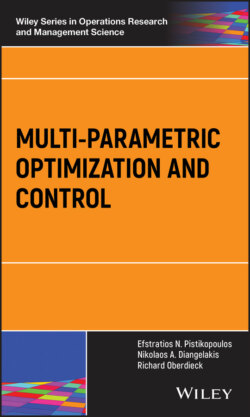Читать книгу Multi-parametric Optimization and Control - Efstratios N. Pistikopoulos - Страница 33
Proof
ОглавлениеSee [1].
If there exist Lagrange multipliers, and , such that the first‐order KKT conditions hold, then we have:
(1.17)
and the vector is defined as follows:
(1.18)
Furthermore, if there exists for which
(1.19)
the Basic Sensitivity Theorem holds, and it is identically satisfied for a neighborhood around and can be differentiated with respect to to yield explicit expressions for the partial derivatives of the vector function .
The first‐order estimate of the variation of an isolated local solution x() of (1.16) and the associated unique Lagrange multipliers and can be approximated, given that is known and that is available.
In particular, let be the concatenation of the vectors and . The first‐order Taylor expansion of the vector F around can be expressed as follows:
(1.20)
Under the assumptions and the principles of the Basic Sensitivity Theorem, in a neighborhood of the first‐order KKT conditions hold and the value of F() around remains zero. For systems that consist of polynomial objective functions of up to second degree and linear constraints, with respect to the optimization variables and the uncertain parameters, the first‐order Taylor expansion is exact. Hence, the exact multi‐parametric solution can be obtained for the following multi‐parametric quadratic programming problem
(1.21)
where matrices , and , , and the scalars , correspond to the and inequality and equality constraints of the sets and , respectively. This problem serves as the basis that will be discussed in Part I, where its solution properties and solution strategies among other things are in focus. Part II then focusses on the application of such problems to optimal control, as the use of parameters enables the formulation of explicit model predictive control problems.
